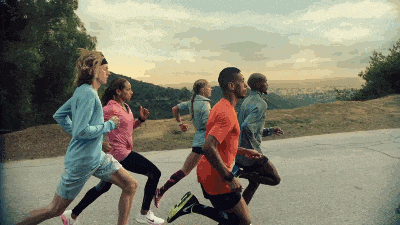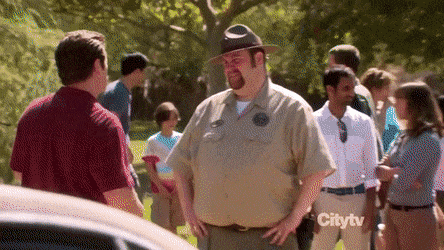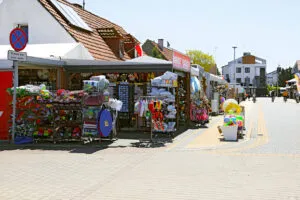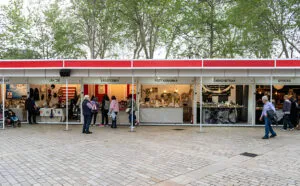Recently updated on May 22nd, 2025
If you’re planning to set up and run a race, you’ll need to make sure everything is ready for your helpers and runners on the day of the race. There are lots of things to think about in race event planning, and being organized can help make your race a success. Here are some important things to consider when you’re organizing a race.

1. Plan the Race Course
As a race director planning your first race or even a seasoned planner organizing a fun run, the course of your event is crucial for a successful event. The course should be in a race location that is easy for runners to navigate and suitable for various skill levels. Whether it’s a 5k race, a 10k, or a marathon, ensuring the course is safe, with the distance measured correctly, is vital for accurate race timing.
Choose a race date that works well for your community and promote it on your race website and event page. This will help attract more participants. Using race course mapping tools can help you mark mile markers precisely and plan the entire race route efficiently.
Remember to consider event safety and event insurance. Engage with local businesses and local running clubs to increase race participation and possibly raise money for a charity race. Offering race shirts and race bags can also boost interest.
For the race planning, including online registration and considering chip timing for the finish line, is essential. With careful planning and coordination, both you and your team can ensure the race is enjoyable and safe for everyone involved.
2. Race Event Planning Permits

No matter where you plan to hold the race, you will need to get permission from the city, county or property owner. Not getting permission far enough in advance could result in your race being canceled. You will likely be required to obtain one or multiple permits for your race to receive the proper authorization.
3. See How Other Races are Organized
Learning from others is key for race directors, especially if you’re looking to organize a 5k or other types of runs like fun runs and longer races. Researching and observing how other races are conducted can provide valuable insights for your first year race.
When examining other races, focus on three golden rules of race organization: safety, participant experience, and community engagement. Look at their course certification, how they manage aid stations, and their setup for different age groups.
Observing the planning process of these events, from how they manage their registration form to crafting a press release, can offer useful ideas for your event. Check how they collaborate with local authorities, USA Track and Field for certifications, or partner with local restaurants for post-race activities. Pay attention to their race names and themes, which can inspire your own race name and theme.
Attending these events, either as a participant or a spectator, or simply visiting various race event planning websites, can give you a comprehensive view. This includes understanding the placement of water stations, the logistics of working with a running group, and setting an appropriate entry fee. All this research and observation will significantly aid your race event’s success.
4. Race Event Planning Theme and Name
Many races have specific themes to try to set themselves apart from other races and entice more runners to enter. Your race could celebrate a certain holiday or involve people running in costumes. Some races that are on the less-competitive side center around foods or drinks (such as chocolate or wine). For a more challenging event, you can try organizing a military-style race complete with an obstacle course. Choosing a catchy name for your event that reflects your race’s theme will also be an effective way to generate interest from participants.
5. Race Event Planning Racer Signup
If you do not advertise the race effectively, you could end up with a very small turnout on race day which would not be good for your race event planning. Printing flyers and posting them in various parts of the city or town in or near where the race is expected to be held can get people interested to sign up for the event.
Advertising in a print or an online magazine that is geared toward runners can also be beneficial. You might even consider paying for ads online to promote your race to a wider range of people. Of course, social media is also an effective marketing tool. You can even try creating banners and signs and contacting local news stations to promote your event to a wider audience.
6. Registration Process Race Event Planning
A registration process that is confusing or otherwise difficult could result in fewer participants.
Having runners register online through a website that allows easy signup and payment processing is generally the way to go, but you can also choose to have runners sign up in person. If you want people to sign up online, there are event-management software programs that can simplify the process.
7. Raise Funds
It takes money to put on a race, and raising funds from different sources will make it possible for you to host the best event imaginable. Along with funds raised from race entry fees, you can try getting money from corporate sponsors who will be interested in working with you in exchange for letting them advertise their brands at the race. You can also ask for extra money by way of charitable donations. Establishing a budget before the race will allow you to know exactly how much money you need to raise versus what you plan to spend to organize the race.
8. Get Your Race Event Planning Staff Organized
Most races rely on the support of volunteers, but you can also choose to hire paid staff members to help you conduct your event. Race event planning directors should be on staff to manage the logistics of the race. Staff will be needed to hand out race numbers and goodie bags to runners. Depending on how long the race is, you might also need people to hand out drinks and snacks at designated stations along the course to runners. Staff members should be stationed at the start and finish lines so that accurate race times can be recorded.
9. Race Event Planning Medical Personel

Runners can get injured during a race, and you will want to have qualified medical personnel on staff who can provide the necessary care. Muscle strains, dehydration and overheating can all cause someone to require prompt medical attention to avoid further problems. Your medical team should also have a full stock of all the necessary supplies to administer the proper care. If you plan to organize a longer race like a marathon, having a medical tent onsite and aid stations will be especially good for your runners.
10. Protect Against Liabilities
You don’t want to be held legally liable for anything that might go wrong, and sufficient liability protection prior to the race can keep you out of trouble. Getting insurance coverage for the event is one of the best ways to avoid litigation if any runners suffer injuries or other problems and want to hold you accountable. Having runners sign waivers stating that they are aware of the risks of running and accept these risks can also keep you out of trouble.
11. Get Race Gear for Race Event Planning
Race bibs that display numbers for your runners and have timing stubs with barcodes to accurately record participants’ finishing times will be important to have. You should also order medals or trophies to award to the top finishers in your race. You might even choose to get finisher medals to give to all participants. T-shirts that are available in different sizes and feature the name of your race can be ordered as well. Goodie bags are also good to offer, and they can be filled with healthy snacks, simple souvenirs and other gear that may be furnished by race sponsors.
12. Choose On-Course Snacks and Drinks
To ensure runners stay hydrated and energized, it’s important to set up food tables with drinks and snacks along the race course. At these stations, offer small cups of water or sports drinks that are free of caffeine or diuretics to avoid dehydration. Energy bars and gels are great options for on-course snacks. For races as long as a half or full marathon, it’s also crucial to have snacks and drinks at the starting line and in the finish area. This allows runners to refuel post-race.
Engaging with potential sponsors can be a strategic move, especially for providing quality snacks and drinks at these stations. Additionally, incorporating learnings from other events can help in enhancing the overall runner experience at your race.
13. Arrange an Expo (optional)
Setting up a runners’ expo before the race is a great way to build excitement, especially for marathons. At the expo, provide all the details about the race course through informative marketing materials. This is an excellent opportunity to engage your target audience with more than just the race itself.
Allow race sponsors to set up booths at the expo. Here, they can sell products or give away free samples, appealing to your target audience of runners. Items like running shoes, jackets, and other gear can be featured at these booths, making the expo a one-stop shop for participants to gear up and learn more about the race.
14. Race Event Planning Reserve Course Equipment
Your race event planning should include course equipment that will help runners stay on track. Cones, barriers, and ropes can be used to line the course so that runners don’t wander astray accidentally. Timing equipment at the start and finish lines should also be set up to record accurate race times. If the race is expected to take place at night or when outdoor light is limited because of the weather, lighting equipment along the course should be in place. Sound equipment that plays music can also be used to get runners more excited about running the race.
15. Install Portable Toilets
Nature may call at any time, and this is especially true while running. Having portable toilets stationed at the start and fini sh areas should be standard protocol for any race. If the race is longer than a 5k, you will also want to have portable toilets stationed along parts of the course. These portable toilets should be stocked with enough toilet paper for the number of runners that you expect to participate. Handwashing stations outside the portable toilets are also advisable to prevent the spread of germs.
16. Offer Optional Course Tours
If you are organizing a longer race that covers the distance of several miles, offering tours of the course can help runners feel more assured about what to expect. The tour may include a bus ride along the course with a tour guide to explain the different sections and answer any questions. You may choose to offer these tours for free to registered race participants or for an additional fee.
17. Find Ways to Create Excitement for Next Year’s Race Event Planning
If your goal is to turn your race into an annual event, especially when planning a 5k or 10k race, it’s crucial to keep race participants excited about next year’s event. This enthusiasm can lead them to spread the word to friends and family, potentially boosting participation in the following year.
One effective strategy is to offer coupons and other freebies as a token of appreciation. This not only shows gratitude to those who participated but also encourages them to return for future races. Enhancements like a well-equipped aid station and a robust sound system can significantly improve the race experience, leaving a lasting positive impression that makes runners eager to come back.
18. Race Event Planning Post-Race Day Cleanup
The racecourse and start and finish areas will likely be in a messy state once the race is over. The trash from used cups, energy packs and snack bar wrappers may be littered throughout the location, and you will want to have staff members who are available to assist with post-race cleanup duties. The portable toilets may also need to be cleaned before being returned to the company that loaned them. Also, you will need to take down the race equipment that was used to mark the course and record start and finish times.
19. Have a Way to Post Race Results Quickly
Runners are often eager to find out their finishing times to check if they’ve set a new personal best. To cater to this, you can post the results on the race event planning website quickly, ideally within 24 hours or a few days after the race ends. These results should list each runner’s name, bib number, and finishing time. You might also consider including split times at various course points.
For easy access, provide a direct link to the results page on your website. This ensures that participants can effortlessly find their times and share their achievements.
By paying attention to these details, your race event planning will be more efficient. Following these guidelines will help you organize an event that will be positively remembered for its smooth execution and attention to the runners’ needs.
FAQ
How can I attract participants to my race?
Attract participants by creating a clear, engaging website. Promote the race on social media and local boards. Offer early-bird discounts and group perks. Highlight unique features like scenic routes or post-race fun. Partner with local businesses for sponsorships.
What permits are needed to organize a race?
To organize a race, you’ll need permits like special event and road closure permits. Requirements vary but may include insurance, safety plans, and police coordination. Check with your local office to meet all rules.
How to organize a 5K run ?
Planning a 5K run starts with picking a date and finding the right location. You’ll need permission from your city and a safe route for runners. Add signs, water stations, and friendly volunteers along the way. Invite local businesses to sponsor the event or donate supplies. Use an online sign-up form and spread the word through social media, flyers, and local running groups.








